-
This paper aims to establish an “Indian” view point to appreciate the
temples with our own method of understanding the Temple architecture.
Introduction
Indian temple is considered to be a
pinnacle of Indian architecture, which is identified as a soul of Indian
culture worldwide. Historically, the temples had a cultural & social
significance. The social fabric was closely knit wherein temples were integral
part of the religious and educational system. Amongst all other architectural pieces
of heritage of India like Forts, Palaces, gardens, tombs etc. temples are one
of the oldest form of architectural manifestation of Indian culture, which is directly
associated with the philosophy of Indian Culture.
The temples like Brihadishwara in
Tanjore, Lingaraja temple in Bhubaneshwar, Temples at Vrindawan, Vishvanath
temple at Kas̅hi, Dwaraka and group of temples at Khajuraho are associated with
the lives of people. Though from the point of view of the common people these
are of utmost religious importance irrespective of the structure itself. It is
evident that there was a reason beyond the specific form and structural
manifestation of these temples. The structure of temple; though varied from
region to region e.g. Nagara, Dravida, Vesara etc,
had
their roots in the various Shastra and Sciences
; on the basis of which
the rituals of the gods were performed (Nagaswamy, R. 2010) and hence based on
this overall architectural form was derived.
From 6th to 16th
AD, it was also demonstrated in the other countries dominated by the Indian
Culture like Cambodia (Cambuja), Thailand (Shyam), Laos (Lav Desh), Bali and
others parts of South East Asia.
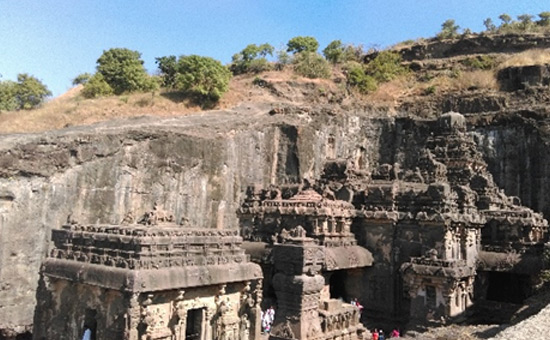 Kailasa Mandir, Ellora. Pic by Author.
Kailasa Mandir, Ellora. Pic by Author.
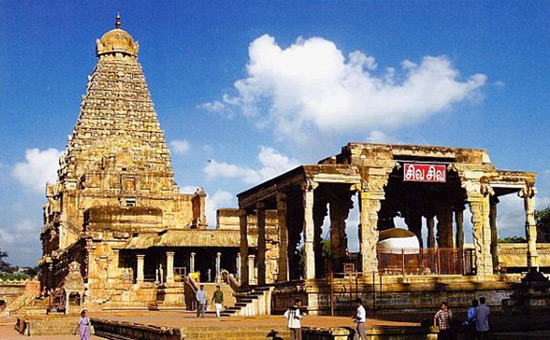 Brihadishwara Temple, Tanjore. Pic by Author.
Brihadishwara Temple, Tanjore. Pic by Author.
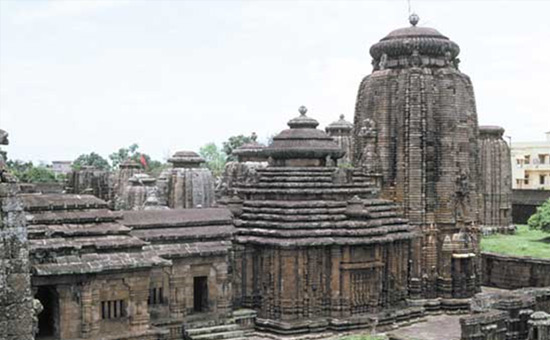 Lingaraja Temple, Bhubaneshwar. Pic by Author.
Lingaraja Temple, Bhubaneshwar. Pic by Author.
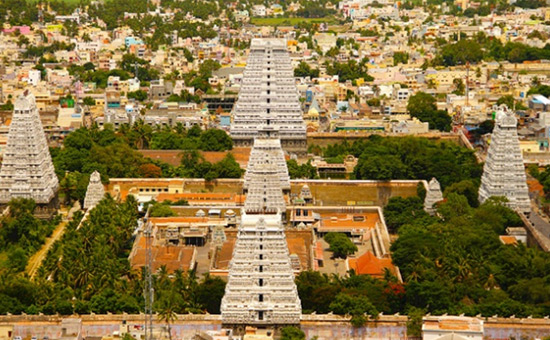 Meenakshi Temple, Madurai. Courtesy www.indiatraveltours.com
Meenakshi Temple, Madurai. Courtesy www.indiatraveltours.com
The temple construction was comprising the
philosophy stated in earlier Purans, various Granthas and gradually developed
for its spatial arrangement, structural forms and decorations. The sthapatis were trained to interrelate
the Shastras with Prayoga.
Over a period of time, the link of the knowledge
base with its practical implementation is lost. Today, the Indian arts are
studied in isolation with various perceptive the focus being on chronologies,
styles etc. The major reason for this is that the literature available is written
and published by western authors during British rule. Even today, basic
understanding of the temples is perceived with a western perspective.
For the holistic study of the temples, it
is important to study them with the base of our own traditional knowledge
system & understand the metaphysical aspect of it which goes beyond the
guidelines established by the western authors.
This
paper
aims to establish an “Indian” view
point to appreciate the temples with our own method of understanding the Temple
architecture
. It is an attempt to establish a need to study Indian
Temple Architecture with the ‘Indigenous’
methodology.
Overview of Philosophy of
Temples
The philosophy of Indian art forms goes
back to the Vedic period where all the principles were established through the
Shashtra & Puranas.
Temples were perceived as a visual
representation of the cosmic power on earth. The God who inhibits this abode is
said to be seated with his consort on the summit of the metaphysical mountain,
surrounded by a circle of peaks in which the divine power descends in
diminishing potency as it comes down gradually and takes his abode at the peak
of the circle, appropriate to his direction and also relative importance in the
hierarchy. This enables the devotee to see the image of his devotion within his
immediate reach. This metaphysical mountain is called the great Me̅ru - Mahameru, which forms the basic concept
of the Shiva temples. The perfect example of this is Brihadiswara temple,
Tanjore.
The Hindu philosophy revolves around the
three important gods Brahma (The creator), Vishnu (The Savior) and Shiva (The
destroyer). The Vishnu and Shiva, being the savior and destroyer of the
universe, have varied forms. To understand the role of each of these it is
important to understand the basic cosmological principles. (
Khot U, Chakradeo U,
2015
)
In Brahmanical
cosmology,
Our universe is transformed into four
distinct and successive time periods i.e. Yugas, repeated over and over again,
in a sequence of Satya, Treta, Dvapara, and Kali. Of these four cycles the Kali
Yuga, our own time period, is the worst of all. During which the human life
span is shortest and wars and famine are common, morality and ethics are all
but lost. Till ill-fates time cycle lasts for 432,000years and according to the
legend began a few thousand years ago, after the end of Mahabharata War. (Mannikka, E. 2000)
|
Yuga
|
Celestial Years
|
Terrestrial Years
|
|
Satya
|
4800
|
1,728,000
|
|
Treta
|
3600
|
1,296,000
|
|
Dvapara
|
2400
|
864,000
|
|
Kali
|
1200
|
432,000
|
Time does not stop here and the cycle
continues till the final and total dissolution.
4 Yuga cycle = 1 Mahayuga (4,320,000
years)
14 Mahayugas + 15 Kŕta Yugas (Between
each Mahayuga and at the end) = 1 Kalpa
720 Kalpas (360 days and 360 Nights for
Brahma) = 1 year of Brahma
100 years for Brahma = Dissolution of
universe at all levels
Brahma merges again with the sleeping
Vishnu.
The manifestation of this philosophy of Ka̅l can
be
seen in the Vishnu temples
, the perfect e.g. of which is Angkor Wat
temple, Cambodia.
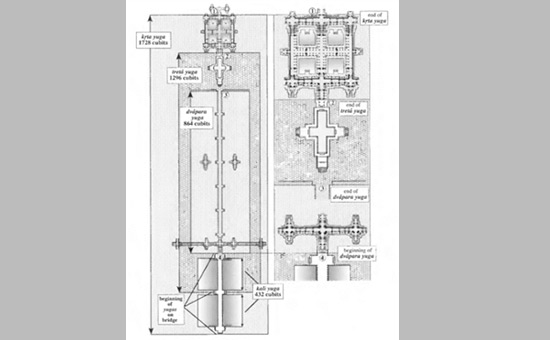 Diagram of 4 Yuga Cycle on western axis. (Credit: Mannikka,
Eleanor. Angkor Wat: Time, Space and Kingship)
Diagram of 4 Yuga Cycle on western axis. (Credit: Mannikka,
Eleanor. Angkor Wat: Time, Space and Kingship)
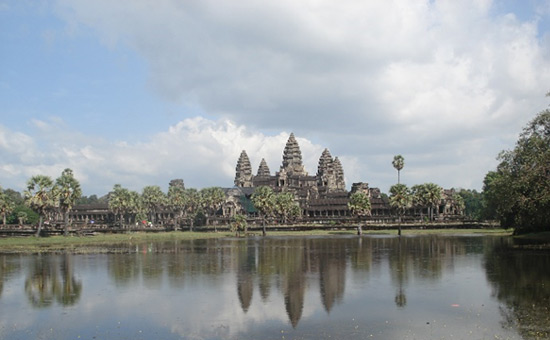 Angkor Wat Temple, Siem Reap, Cambodia. (Credit: Author)
Angkor Wat Temple, Siem Reap, Cambodia. (Credit: Author)
As stated by Ra̅machandra Kaulaca̅ra̅,
an 11th century Orissan Architect “
He, the creator (Viśhvakarma), lays out the plan of the universe
according to measure and number. He is the prototype and the model of the
temple builder, who also units in his single person, the architect, the priest,
and the sculptor. This small universe (the temple) has to be situated with
respect to the vaster universe, of which it forms a part. It has to fall into
line with the position of the earth in relation to the course of sun and also
the movements of the planets.”
(
Kula̅ca̅ra, 1966)
The philosophy of the temple can be
drawn from the Purana, which help in comprehending the Form (the ru̅pa) and the
formless (the aru̅pa). The movement is from ru̅pa to the beyond. As per the
traditional sciences, there is an interrelationship of Shastra and Prayoga i.e.
the oriental literature and the practical application. To facilitate the later,
there were efforts to document the principles in various forms.
Sutradharmandan
has
written various Grantha on the Shilpashatra. Prasadamanadan is the book which gives an overview of the
construction of temples. (Nagar Style). Vastumandana,
Vastushastra and Vastusaar are the books which give the construction of buildings. Devata Murti Prakaranam and Roopmandan are the books based on
Sculptures in temples. Aparajitapruchha gives
the Comparative methods of Principles and practice of the science of Vastu. Aayatatva gives the calculations of Aay
(earning), Vyaya (spendings), Nakshatra (Planets), Tara (Stars), for the
building construction.
It is believed that during the period of
Sutradarmanadan, the information on
the Shilpashastra was scattered and
not documented properly, also this was the time when the Indian traditional
construction was on decline mode, so Sutradharmanadan
has compiled all the shastras and revived the documents and hence the
construction activity.
Western outlook for the temples
During the British era, there was
literature published to evaluate the architecture of these temples. Due to lack
of indigenous knowledge of Indian traditional sciences, these temples were
interpreted in a very superficial manner restricting the explanations only to
the structures without any in-depth understanding of the Philosophy of the
construction of the temples. This method is still being adopted by majority of
the scholars to understand the temple architecture.
Another major setback was lack of
information about the Indian History before the written documents were maintained.
James Fergusson in his book History of Indian and eastern Architecture,
published in 1910, states –
“
The
greatest difficulty that exist, in exciting an interest in Indian Antiquities
arises from the fact that India has no history properly so called, before, the
Muhammadan invasion in the 13th Century.
The sequence of events, wars can be taken from Puranas, which is still
not a historical document. Buddhist literature, gives account of the historical
events, and these can be taken as a historical account.
He further states that ‘
The south Indians had no aspirations, they
had no history to which they could look back with pride, and their religion was
an impure and degrading fetishism. It is
impossible that anything very grand or imposing should come out of such a state
of things[i]
.”
(Fergusson, 1910)
He believed that – “
The Dravidian temples are a fortuitous aggregation of the parts,
arranged without plan, as accident dictated at the time of their erection, and
without plans, no adequate idea could be conveyed to those who have not seen
them”.
The
whole exercise of constructing temples was merely put up as a meaning less work
done to exhibit flashiness as there was no other way to spend the money of the
kings collected by the revenues out of farming. With this bias and limited
understanding of the religion, it is evident the description of the temples
would be restricted to only the physical form.
Here, it is important to give the credit of documentation of the structures to James Fergusson
,
who travelled extensively and documented them, sketched these. This is an
important document for reference, the only point of deviation is the way the
structures are observed.
This book by James Fergusson was a reference
by succeeding historians for many years to come. The authors like Percy Brown
in his book Indian Architecture (Buddhist & Hindu) do not deviate from the
method of describing these temples but mentions the “spiritual” aspect of the Indian temples. He states that -
“
The
fundamental purpose of the building art was, to represent in concrete form the
prevailing religious consciousness of the people. It is Mind materialized in
terms of Rock, Brick or Stone”.
During the same period, the historian E.
B. Havell, in his book-
The History of
Aryan Rule in India, from earliest times to the death of Akbar,
believed
that
“
It
is important to show as accurately as possible the relationship between
different schools of religious thoughts and their influence upon political
ideas, for there can be no true history of India which separates politics from
Religion. He put forward the aspect of psychological standpoint upon which the
Aryan political system was based which influence the architectural activity in
the region.
”
All the above authors, apart from being
ignorant about the meaning behind the temple, observed only the structural
elements like columns, roofs/ Shikharas, podiums (pitha) and gauge the temples
on the standards of Greek & Roman styles.
The important aspect is that western
scholars do not consider the oriental literature as an authentic source of
information and written documents are in scarcity due to various invasions in the
last two thousand. So the available resources which they authenticate; are
limited.
Comparison
of Western outlook vs Indian view point
Example:
Bruhadeshwara temple, Tanjavur:
Temple constructed by Rajaraja Chola-I
in AD 1010, who was guided by his guru – I̅śa̅na Si̅va Pan̩d̩ita, and it was
executed by architect Rajaraja-perum-taccan. (Nagaswamy, 2010)
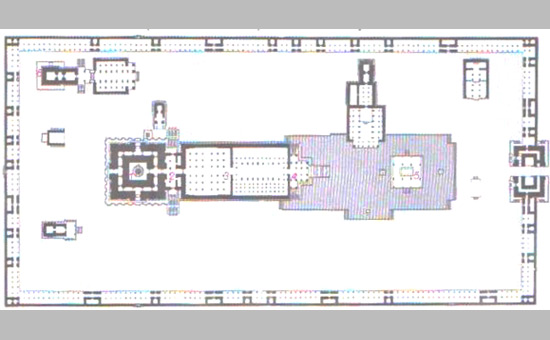 Plan of Brihadishwara Temple. Ref Tranjavur Brhadisvara, an Architectural Study by Pierre Pichard.
Plan of Brihadishwara Temple. Ref Tranjavur Brhadisvara, an Architectural Study by Pierre Pichard.
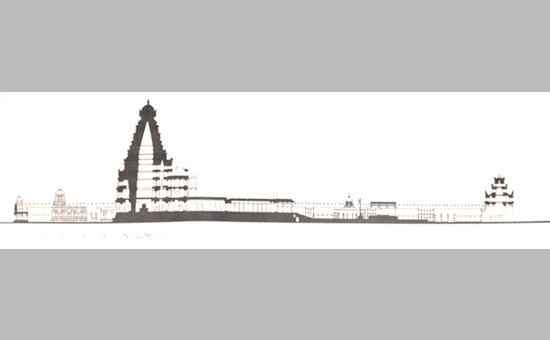 Section of Brihadishwara Temple. Ref Tranjavur Brhadisvara, an Architectural Study by Pierre Pichard.
Section of Brihadishwara Temple. Ref Tranjavur Brhadisvara, an Architectural Study by Pierre Pichard.
James Fergusson
:
describes the temple as an exception to the rule that the larger Dravidian
Temples are arranged as accident dictated.
The Shikhara mentioned as Pagoda is commenced on a well-defined and
stately plan. He goes on explaining the temple on the basis on plan which shows
that the compound has two courts, one a square originally devoted to the minor
shrines and residences. The proportions of the temple, as he claims are
extremely well, the distance between the gateway and the temple being broken by the shrine of the Bull Nandi
which is sufficiently important for the purpose, but not so much as to
interfere with the effect of the Great Vimana.
The great temple is dedicated to the
worship of Siva, as Brihadiswara, in the form of an enormous Linga, and
everything in the inner courtyard belongs to the Śaiva Cult.
He looked at the sub-shrines ‘
as a piece of decorative architecture’. The
pillars are alternatively square and octagon, with the shafts attached on the
two side faces and the whole very richly ornamented.
Percy Brown
: in
his book Indian Architecture – Buddhist and Hindu, categorizes this temple as a
Dravidian Style temple under Cholas.
His point of reference to explain the
temples built during Chola reign is Cathedrals. While talking about the
Shikhara of Brihadishwara temple, which is 190 ft high, he states that –
As a measure of its size the Vimana is equal
in height to the central tower of Worcester Cathedral, but the temple as a
whole is only one thirds the area of this Gothic example.
Moving forward, he explains the “Axiallity” of the temple complex. The
sculptures and motifs on the Shikhara are mentioned as the decorations and
“architectural
manipulations
”. The façade of the temple consists of an assembly of admirable artistic elements, but not in every instance architecturally adequate.
He even analyses the architectural
texture, and aesthetical quality of the temple based on the horizontal lines
maintained in the Shikhara and
culminated
with the rounded cupola at the summit.
The shape of the Vimana is compared
to the Pyramids and he mentions that it is for the convenience which
conveys the
impression of solid strength.
From above two examples, it is evident,
the temple is described with a focus on the plan form, elevational treatment
and the decorative elements.
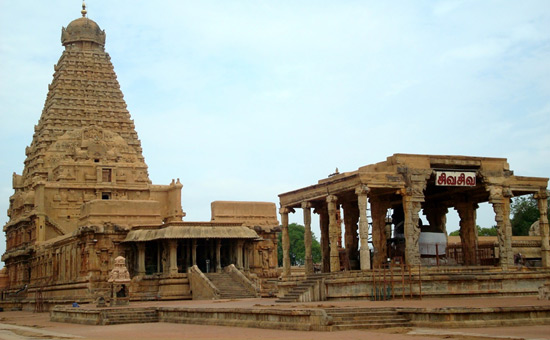 Brihadishwara Temple. Pic by Author.
Brihadishwara Temple. Pic by Author.
Indian View point
From the study done by R. Nagaswamy
published in the book -
Br̩hadi̅śvara
Temple- Form and Meaning
, the temple is a visual representation of cosmic
power on earth. The Metaphysical mountain is called the great Me̅ru- Maha̅me̅ru,
which forms the basic concept of the Brihadisvara temple of Tanjavur. All the
literature mentioned in ancient Indian literature about Meru and its encircling
peaks are incorporated in the physical temple by Rajaraja, the builder, in this
temple which he called as Daks̩in̩a Me̅ru
– Southern Meru. He consecrated two important metal images in this temple - “Maha̅me̅ru Vit̩ankar” and “Daks̩in̩a Me̅ru Vit̩ankar” as if
emphasizing the concept.
Me̅ru, a mythical mountain is said to be
a golden mountain. True to its nature, Rajaraja covered the superstructure with
gold that made this loftiest temple at that time.
The images on the upper tiers with bows
and arrows in their arms are the innumerable Rudras call Sata-Rudra, who are
said to move in the upper spheres and represents the sun’s rays, a
representation unique to this temple.
This temple also portrays the five forms
of Pan̅ca Brahmans- Tatpurus̩a, Agho̅ra, Sadyo̅ja̅ta, Va̅made̅va ad I̅śa̅na,
in individual sculptural forms.
With four sides of the sanctum provided
with openings and its height exactly double its width at the base, the tower
fulfills all the requirements of the Me̅ru type of Temple architecture.
Other manifestations of Siva are
personified as
A̅yudha-purus̩a as
Dva̅rapa̅las
.
This temple locates for the first time
in Indian History, 108 forms of
nr̩tta
kara̩nas
which reflects the concept of cosmic space in which Śiva’s Dance
takes place.
The dance sculptures strictly follows
the sequence given in Bharata’s Na̅t̩yaśa̅stra.
The subsidiary shrines are later
additions to the temple by subsequent kings as per the rituals and traditions
followed during the era.
Conclusion
As stated by Kapila Vatsyayan, in
Kalatatvakosa
- the Indian Arts have been
largely studied in isolation, with much emphasis being given to chronologies
and stylistic analysis along Western Lines.
Various historians, authors, scholars,
anthropologists and other allied professional have studied the temples with
their individual perspectives. But the holistic approach is still missing. The
questions of meaning and the interdependence between the Arts and other
disciplines have received relatively less attention. Literary and
art-historical studies have rarely been combined, so as to do justice to both. Considering
the complexity of the whole process of temple construction, it is significant
to understand the process and the ‘meaning’ with which the temples were
constructed.
It is unfortunate that there is an
ignorance to understand our own traditional knowledge which created our most
important temples not only in India but also in other parts of the world.
Traditionally, the knowledge from
Shastra was transferred to next generations having the intellect of
understanding the complexity of these principles, creating a different league
of Sthapatis. This traditional
knowledge system is still existing in remote villages of India, but no longer fit
into today’s main stream education. The link of the philosophy of these temples
and practical application is missing due to which it is difficult to appreciate
the temples holistically.
There is scope to evolve a new method of
accessing the temples which is independent of guidelines established by the
western authors. The efforts to develop an understanding of the metaphysical
aspect needs a focus.
The Indian
way of appreciating the temples is to understand the Shastra and Pra̅yoga i.e.
oriental literature and the Practical application. It is to organize the
philosophy of temples, the art form, the iconography, the sculptures, spatial
relationships, materials and even the way of manifestation with the help of
existing structures and vast traditional literature.
It is to prove Sarvam̩ Sarva̅tmakam – everything is related to whole.
Authors are 1. Ar. Ujjwala Khot- Palsuley, Associate professor, M.M. College of Architecture, Pune and 2. Prof. Dr. Ujwala Chakradeo, Principal, Smt. Manoramabai Mundle College of Architecture, Nagpur.
Also read / see pictures
1
Kailasa
Temple Ellora
2
Brihadesvara
Temple Tanjore
3
Meenakshi
Temple Madurai
4
Architecture
of Shiv Mandir in Indonesia Prambanan
5
Space
and Cosmology in Indian Temples – Angkor Watt
References
1.Nagaswamy, R. (2010). Brhadisvara
Temple: Form and Meaning. Aryan Books International.
2. Khot Ujjwala & Chakradeo Dr
Ujwala, (2015). Research paper- ‘Indian Architecture as an inspiration for
Cambodia’, published in the conference proceedings of National Conference on
Emerging Trends in Engineering, Technology & Architecture – NCETETA 2015,
Vol-I, ISBN 978-81-920561-6-6.
3. Mannikka, Eleanor. (2000). Angkor Wat: Time, Space and Kingship, University of Hawai'i Press.
4. Kula̅ca̅ra, Ra̅machandra. (1966)
Śilpa Praka̅śa, trans. Alice Boner and Sadashiv Rath Sharma, London, Brill
1966.
5. Fergusson James, (1910) History of
Indian and eastern Architecture, published by John Murray, Albemarle Street,
W., Page no: 351.
Bibliography:
1. Coedes, George (1968). The Indianized
States of Southeast Asia. Honolulu: East-West Center Press.
2. A.P.Patnaik, (1992). Kalingan Link
with Countries of South-East Asia, in: Orissa Review (hereafter OR), vol.
XLVIII, no.9, (April), p.25.
3. Coomaraswamy, A. K., (1972). History
of Indian and Indonesian Art, New Delhi (Munshiram Manoharlal), p. 157.
4. Fletcher, Sir. Banister. (1992). The
History of Architecture. New Delhi: CBS Publishers and Distributors.
5. Pillai J.M. Samsundaram, (1948). Temple
architecture of Cholas, Madras, Authors’ publishing home.
6. Srinivasan K R (1998). Temples of
South India National book trust, New Delhi
7. (1960) Temples of south India, India government
Info & broad info of temples.
8. Grover Satish (2003). Buddhist and
Hindu Architecture in India, CBS publishers & distributers Pvt Ltd, Delhi.
9. Hebalkar, Dr. Sharad, (2010),
Krunvanto Vishvamaryam, Akhil Bharatiya Itihas Sanshodhan Yojana, New Delhi.